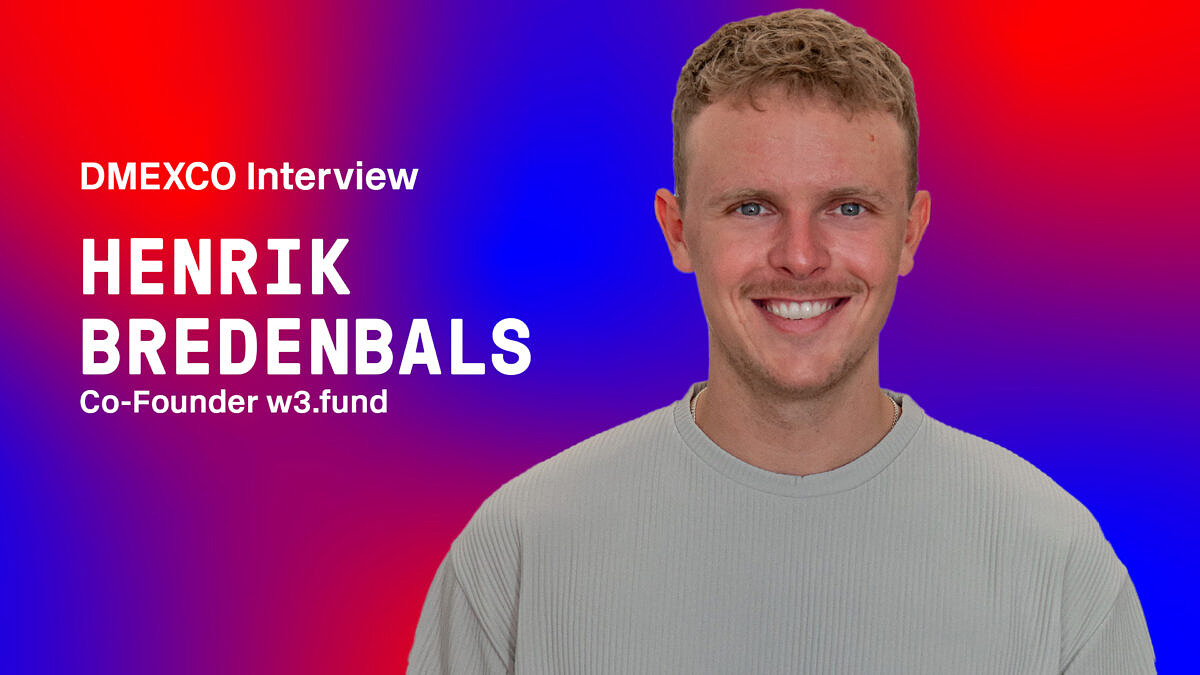Henrik Bredenbals from w3.fund joins DMEXCO for an interview
Web3 is the scene’s hype – and DMEXCO 2022 is also embracing it. In collaboration with w3.fund, the first-ever w3.vision will be held this year as an exclusive deep dive into Web3. We spoke to w3.fund’s Henrik Bredenbals ahead of the event.

Web3: Henrik Bredenbals from w3.fund discusses the Internet of the future
The metaverse, NFTs, and blockchain – what is Web3 capable of and to what extent will it shape our digital future? In cooperation with w3.fund, DMEXCO 2022 presented the w3.vision, bwhere the leading Web3 experts from all over the world came together to discuss the hottest Web3 trends and share exclusive insights with the DMEXCO community. Henrik Bredenbals, co-founder of w3.fund and already a speaker at the DMEXCO Spring Summit, was of course also there and had already answered important questions about Web3 in advance.
Could you describe what Web3 means for you in one sentence?
Henrik Bredenbals: Web3 is a technology that brings digital ownership to the Internet and is based on decentralization.
What aspect do you find the most fascinating?
Henrik Bredenbals: Blockchain technology has created an ecosystem of products that are decentralized and interoperable. Instead of being dependent on central servers, Web3 stores and authenticates data on globally distributed nodes. At the same time, “digital wallets” secure your Web3 identity on the blockchain. If you compare it with Web2, Web3 allows you to log in with an identity or login details and interact with the platforms, regardless of the provider.
Furthermore, Web3 has given rise to new applications, whether it’s NFTs bringing ownership to the digital world, DAOs (decentralized autonomous organizations) creating new business and voting mechanisms, or DeFi (decentralized finance) revolutionizing the finance market. What’s fascinating is being part of a space that is rapidly evolving and offers great potential for interacting more efficiently and independently.
What particular advantages does Web3 present to companies, brands, and artists?
Henrik Bredenbals: NFTs especially allow companies and brands to form a stronger bond with their audience and expand their product lines into the metaverse/the digital world. That is changing how customers experience and engage with a brand.
The ultimate goal should be for every company that comes into contact with Web3 to use Web3 as a basis for building a multifaceted digital customer bond through community building, ownership in the form of NFTs, and tightening of assets.
As for artists, Web3 primarily enables them to protect their digital works and, in contrast to the offline world of art, to reap long-term benefits. Thanks to royalties, which can be determined by the publishers on the marketplaces, the artists earn something for every sale because a percentage of the sale price goes back to them.
Blockchain also has serious disadvantages, though: How is the technology going to achieve climate neutrality?
Henrik Bredenbals: It can’t be denied that blockchains such as Bitcoin and (currently still) Ethereum have dreadful energy footprints. The “proof of work” consensus mechanism, where Bitcoin miners ensure the authentication of every transaction, is a big resource guzzler.
In contrast, Ethereum is about to be “merged” and its authentication mechanism is set to be switched to proof of stake, meaning that no inefficient mining capacities have to be wasted. At the same time, there are already lots of climate-neutral and resource-friendly blockchains based on other consensus mechanisms and technical methods.
For those who don’t want to leave the Ethereum blockchain, there are more and more “sidechains” and “rollups” – technical methods that outsource authentication and make it much more efficient. So, there’s hope and, above all, solutions that are already being used. It is therefore a great misconception that blockchains are generally bad for the environment.
Will we really drink coffee in the metaverse one day? Or how will it be incorporated into everyday life?
Henrik Bredenbals: The question we need to ask ourselves is whether we’re not already living in a kind of metaverse. The smartphones and social apps we use, the connectivity of our cars, or video calls at work – it’s hard to imagine our lives without all of these things. At the same time, technology is constantly advancing. The logical consequence is that our environment will increasingly shift to mixed reality.
It’s not inconceivable to us that we might soon be having a coffee with each other in the virtual world or visiting a shopping mall in digital spaces. However, the full-blown adaption and metaverses currently being talked about all the time are still 7 to 10 years away.
What will the devices of tomorrow be like? How will we use Web3 in the future?
Henrik Bredenbals: The technology already exists with VR (virtual reality), but it’s not advanced enough yet to make it available for everyone to use. A good middle way and probably the most widespread use case right now is AR (augmented reality), which blends both the online and offline world. Nevertheless, it’s realistic that interfaces will be expanded for VR technology and we will frequently use the corresponding hardware (VR glasses) in the future to immerse ourselves in the world of the Internet.
Do you want to know more? Then visit our DMEXCO community platform to watch all the highlights from DMEXCO 2022, free of charge and in video-on-demand quality. Register now and enjoy exciting sessions, masterclasses, and lectures!





